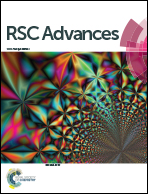Evaluation of kaolin floc characteristics during coagulation process: a case study with a continuous flow device†
Abstract
In this study, we used a continuous flow device to simulate actual water treatment works and explored the impact of the coagulant dosage and shear rate combination on kaolin floc properties. The results indicated that an increase in coagulant dosage contributed to larger floc size and more compact floc structure. As coagulant dosage further increased, both floc size and fractal dimension were reduced. For different shear rate combinations, the floc size during the transitional phase increased with the decrease of fractal dimension, followed by the reduction of floc size and increase of floc density in the steady state because of the breakage and restructure of flocs. Considering that the actual coagulation process aims to generate large flocs without breakage, this indicates that the time to reach a steady state for floc size is the optimal coagulation time. Thus, the optimal shear rate combination (59–48–17 s−1) is the one which reached steady state for floc size at the end of the coagulation process. In contrast to constant shear rate, decreasing shear rate enhances the floc growth, leading to similar floc properties for different shear rate combinations. This is the first time temporal evolution of floc size and structure in a continuous flow reactor has been reported.


 Please wait while we load your content...
Please wait while we load your content...